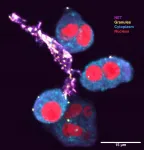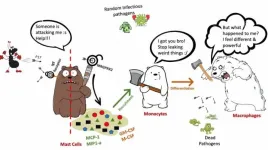(Press-News.org) Many exoplanets have opaque atmospheres, obscured by clouds or hazes that make it hard for astronomers to characterize their chemical compositions. A new study shows that haze particles produced under different conditions have a wide range of properties that can determine how clear or hazy a planet's atmosphere is likely to be.
Photochemical reactions in the atmospheres of temperate exoplanets lead to the formation of small organic haze particles. Large amounts of these photochemical hazes form in Earth's atmosphere every day, yet our planet has relatively clear skies. The reason has to do with how easily haze particles are removed from the atmosphere by deposition processes.
"It's not just haze production but also haze removal that determines how clear the atmosphere is," said Xinting Yu, a postdoctoral fellow at UC Santa Cruz and lead author of the study, published July 12 in Nature Astronomy.
Yu and her colleagues measured the properties of haze particles produced in the laboratory under conditions representative of exoplanet atmospheres, including a range of gas compositions, temperatures, and energy sources. Coauthor Xi Zhang, assistant professor of Earth and planetary sciences at UC Santa Cruz, said laboratory experiments like this are essential for understanding haze formation and its impact on observations.
"We can't bring haze samples back from exoplanets, so we have to try to mimic the atmospheric conditions in the laboratory," he said.
According to Yu, haze removal depends on a critical material property of the particles called surface energy. "Surface energy describes how cohesive or 'sticky' the material is," she said.
Sticky haze particles readily bond with each other when they collide, growing into larger particles that fall out of the atmosphere onto the surface of the planet (a process called dry deposition). They also make good condensation nuclei for cloud droplets and are easily removed by wet deposition. Hazes produced on Earth typically have high surface energy and are therefore 'sticky' and efficiently removed from the atmosphere.
Yu's laboratory experiments show that the hazes produced in exoplanet atmospheres are highly diverse, with properties that depend on the conditions in which they are produced.
"Some of them are similar to the Earth haze, have high surface energy, and are easy to remove, leading to clear skies," she said. "But some of them have very low surface energy, like a non-stick pan; they do not bond with other particles very well and remain as small particles hanging in the atmosphere for a long time."
The study found that a critical factor is the temperature at which the haze particles are created. Hazes produced at around 400 Kelvin (260°F) tended to have the lowest surface energies, leading to less efficient removal and hazier atmospheres. This finding actually corresponds with observed trends, Yu said, noting that exoplanets at temperatures of 400 to 500 K tend to be the haziest.
Cooler planets located in the habitable zones of their host stars are more likely to have clear atmospheres, she said. "We may not have to worry about habitable exoplanets being too hazy for future observations, as hazes tend to have higher surface energies at lower temperatures," Yu said. "So it is easy to remove these hazes, leaving relatively clear atmospheres."
Astronomers are looking forward to having a powerful tool for characterizing exoplanet atmospheres with the upcoming James Webb Space Telescope (JWST). When an exoplanet transits across the face of its star, its atmosphere filters the light from the star, giving astronomers with a sensitive enough telescope (like JWST) an opportunity to identify the chemical components of the atmosphere using transmission spectroscopy.
A hazy atmosphere would interfere with transmission spectroscopy, but the hazes themselves may still yield valuable information, according to Zhang.
"Hazes are not featureless," he said. "With better telescopes, we may be able to characterize the composition of exoplanet hazes and understand their chemistry. But the observations will be very hard to explain without data from laboratory experiments. This study has revealed the huge diversity of haze particles, and understanding their optical properties will be a high priority for future studies."
INFORMATION:
In addition to Yu and Zhang, the coauthors of the paper include UCSC undergraduate Austin Dymont, astronomy professor Jonathan Fortney, and graduate student Diana Powell at UC Santa Cruz, as well as scientists at Johns Hopkins University, Cornell University, University of Texas at Austin, and University of Grenoble Alpes, France. This work was supported by NASA and the Heising-Simons Foundation.
A diet rich in fermented foods enhances the diversity of gut microbes and decreases molecular signs of inflammation, according to researchers at the Stanford School of Medicine.
In a clinical trial, 36 healthy adults were randomly assigned to a 10-week diet that included either fermented or high-fiber foods. The two diets resulted in different effects on the gut microbiome and the immune system.
Eating foods such as yogurt, kefir, fermented cottage cheese, kimchi and other fermented vegetables, vegetable brine drinks, and kombucha tea led to an increase in overall microbial diversity, with stronger effects from larger servings. ...
You're as old as your immune system.
Investigators at the Stanford University School of Medicine and the Buck Institute for Research on Aging have built an inflammatory-aging clock that's more accurate than the number of candles on your birthday cake in predicting how strong your immune system is, how soon you'll become frail or whether you have unseen cardiovascular problems that could become clinical headaches a few years down the road.
In the process, the scientists fingered a bloodborne substance whose abundance may accelerate cardiovascular aging.
The story of the clock's creation will be published July 12 in Nature Aging.
"Every year, the calendar tells us we're a year older," said David ...
The cave of Satsurblia was inhabited by humans in different periods of the Paleolithic: Up to date a single human individual dated from 15,000 years ago has been sequenced from that site. No other human remains have been discovered in the older layers of the cave.
The innovative approach used by the international team led by Prof. Ron Pinhasi and Pere Gelabert with Susanna Sawyer of the University of Vienna in collaboration with Pontus Skoglund and Anders Bergström of the Francis Crick Institute in London permits the identification of DNA in samples of environmental ...
Boosting the body's own disease-fighting immune pathway could provide answers in the desperate search for new treatments for tuberculosis.
Tuberculosis still represents an enormous global disease burden and is one of the top 10 causes of death worldwide.
Led by WEHI's Dr Michael Stutz and Professor Marc Pellegrini and published in Immunity, the study uncovered how cells infected with tuberculosis bacteria can die, and that using new medicines to enhance particular forms of cell death decreased the severity of the disease in a preclinical model.
At a glance
Researchers were able to demonstrate that cells infected with tuberculosis bacteria have functional ...
Ants are omnipresent, and we often get blisters after an ant bite. But do you know the molecular mechanism behind it? A research team led by Professor Billy K C CHOW from the Research Division for Molecular and Cell Biology, Faculty of Science, the University of Hong Kong (HKU), in collaboration with Dr Jerome LEPRINCE from The Institut national de la santé et de la recherche médicale (INSERM) and Professor Michel TREILHOU from the Institut National Universitaire Champollion in France, have identified and demonstrated a novel small peptide isolated from the ant venom can initiate an immune pathway via a pseudo-allergic receptor MRGPRX2. The study ...
Rather than waiting for certainty in sea-level rise projections, policymakers can plan now for future coastal flooding by addressing existing inequities among the most vulnerable communities in flood zones, according to Stanford research.
Using a methodology that incorporates socioeconomic data on neighborhood groups of about 1,500 people, scientists found that several coastal communities in San Mateo County, California - including half the households in East Palo Alto - are at risk of financial instability from existing social factors or anticipated flooding through 2060. Even with coverage from flood insurance, these residents would not be able to pay for damages from flooding, which could lead to homelessness or bankruptcy ...
Led by Professor Robert Read and Dr Jay Laver from the NIHR Southampton Biomedical Research Centre and the University of Southampton, the work is the first of its kind.
Together they inserted a gene into a harmless type of a bacteria, that allows it to remain in the nose and trigger an immune response. They then introduced these bacteria into the noses of healthy volunteers via nose drops.
The results, published in the journal Science Translational Medicine, showed a strong immune response against bacteria that cause meningitis. Published in ...
Through a complex, self-reinforcing feedback mechanism, colorectal cancer cells make room for their own expansion by driving surrounding healthy intestinal cells to death - while simultaneously fueling their own growth. This feedback loop is driven by an activator of the innate immune system. Researchers from the German Cancer Research Center (DKFZ) and the University of Heidelberg discovered this mechanism in the intestinal tissue of fruit flies.
Maintaining the well-functioning state of an organ or tissue requires a balance of cell growth and differentiation on the one hand, and the elimination of defective cells on the other. The intestinal epithelium is a well-studied example of this balance, termed "tissue homeostasis": Stem cells ...
North Carolina State University researchers found that a four-week training course made a substantial difference in helping special education teachers anticipate different ways students with learning disabilities might solve math problems. The findings suggest that the training would help instructors more quickly identify and respond to a student's needs.
Published in the Journal of Mathematics Teacher Education, researchers say their findings could help teachers in special education develop strategies to respond to kids' math reasoning and questions in advance. They also say the findings point to the importance of mathematics education preparation for special education teachers - an area where researchers ...
COLUMBUS, Ohio -- As typical social and academic interaction screeched to a halt last year, many young people began experiencing declines in mental health, a problem that appeared to be worse for those whose connections to family and friends weren't as tight, a new study has found.
In June 2020, researchers invited participants in an ongoing study of teenage boys and young men in urban and Appalachian Ohio to complete a survey examining changes to mood, anxiety, closeness to family and friends, and other ways the pandemic affected their lives. The study, co-led by researchers at The Ohio State University and Kenyon College, appears in the Journal of Adolescent Health.
Nearly a third of the 571 participants reported that their mood ...




